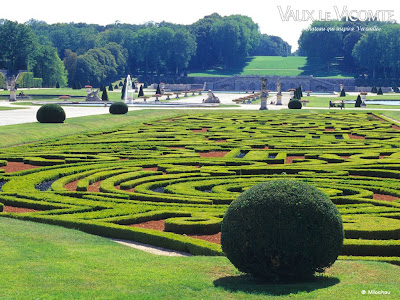
In the early seventeenth century, between the royal residences of Vincennes and Fontainebleau, a small castle stood at the confluence of two small rivers. The domain was called Vaux-le-Vicomte: it was then just a place on the map and its reputation had still to be made. In 1641 a 26 year-old parliamentarian, Nicolas Fouquet, purchased the estate. Fifteen years later the first stone of a unique masterpiece was laid; it was to be the finest château and garden in France. This achievement was brought about through the collaboration of three men of genius whom Fouquet had chosen for the task: the architect Le Vau, the painter-decorator Le Brun and the landscape gardener Le Nôtre. The artistic and cultivated sensibility of their patron was a great stimulus to their talents. They were not alone; the poet La Fontaine, Molière, playwright and actor, Madame de Sévigné, Pellisson and Scarron formed the circle around this great patron of literature and the arts.

Vaux-le-Vicomte was, moreover, the setting for one of the finest "fêtes" or celebrations, of the seventeenth century. It was lavish, refined, and dazzling to behold, but rich in hidden drama. The King had asked to visit, to throw Fouquet off the scent; secretly he had decided that Fouquet would die. Overcome with joy at the chance of parading Vaux-le-Vicomte before the sovereign whose faithful servant he remained, Fouquet assumed that he would take over the post of prime minister vacated by Cardinal Mazarin. Two weeks later Fouquet was arrested. He was never to leave prison alive. It may have been under threat of abandon or destruction, but Vaux-le-Vicomte has survived, thanks to the unfailing determination of three centuries of dedicated individuals. Resplendent today as it was in former times, Vaux-le Vicomte stands as a symbol of the intelligence, taste and independence of its creator, Nicolas Fouquet.
 In the early seventeenth century, between the royal residences of Vincennes and Fontainebleau, a small castle stood at the confluence of two small rivers. The domain was called Vaux-le-Vicomte: it was then just a place on the map and its reputation had still to be made. In 1641 a 26 year-old parliamentarian, Nicolas Fouquet, purchased the estate. Fifteen years later the first stone of a unique masterpiece was laid; it was to be the finest château and garden in France. This achievement was brought about through the collaboration of three men of genius whom Fouquet had chosen for the task: the architect Le Vau, the painter-decorator Le Brun and the landscape gardener Le Nôtre. The artistic and cultivated sensibility of their patron was a great stimulus to their talents. They were not alone; the poet La Fontaine, Molière, playwright and actor, Madame de Sévigné, Pellisson and Scarron formed the circle around this great patron of literature and the arts.
In the early seventeenth century, between the royal residences of Vincennes and Fontainebleau, a small castle stood at the confluence of two small rivers. The domain was called Vaux-le-Vicomte: it was then just a place on the map and its reputation had still to be made. In 1641 a 26 year-old parliamentarian, Nicolas Fouquet, purchased the estate. Fifteen years later the first stone of a unique masterpiece was laid; it was to be the finest château and garden in France. This achievement was brought about through the collaboration of three men of genius whom Fouquet had chosen for the task: the architect Le Vau, the painter-decorator Le Brun and the landscape gardener Le Nôtre. The artistic and cultivated sensibility of their patron was a great stimulus to their talents. They were not alone; the poet La Fontaine, Molière, playwright and actor, Madame de Sévigné, Pellisson and Scarron formed the circle around this great patron of literature and the arts. Vaux-le-Vicomte was, moreover, the setting for one of the finest "fêtes" or celebrations, of the seventeenth century. It was lavish, refined, and dazzling to behold, but rich in hidden drama. The King had asked to visit, to throw Fouquet off the scent; secretly he had decided that Fouquet would die. Overcome with joy at the chance of parading Vaux-le-Vicomte before the sovereign whose faithful servant he remained, Fouquet assumed that he would take over the post of prime minister vacated by Cardinal Mazarin. Two weeks later Fouquet was arrested. He was never to leave prison alive. It may have been under threat of abandon or destruction, but Vaux-le-Vicomte has survived, thanks to the unfailing determination of three centuries of dedicated individuals. Resplendent today as it was in former times, Vaux-le Vicomte stands as a symbol of the intelligence, taste and independence of its creator, Nicolas Fouquet.
Vaux-le-Vicomte was, moreover, the setting for one of the finest "fêtes" or celebrations, of the seventeenth century. It was lavish, refined, and dazzling to behold, but rich in hidden drama. The King had asked to visit, to throw Fouquet off the scent; secretly he had decided that Fouquet would die. Overcome with joy at the chance of parading Vaux-le-Vicomte before the sovereign whose faithful servant he remained, Fouquet assumed that he would take over the post of prime minister vacated by Cardinal Mazarin. Two weeks later Fouquet was arrested. He was never to leave prison alive. It may have been under threat of abandon or destruction, but Vaux-le-Vicomte has survived, thanks to the unfailing determination of three centuries of dedicated individuals. Resplendent today as it was in former times, Vaux-le Vicomte stands as a symbol of the intelligence, taste and independence of its creator, Nicolas Fouquet.
No comments:
Post a Comment